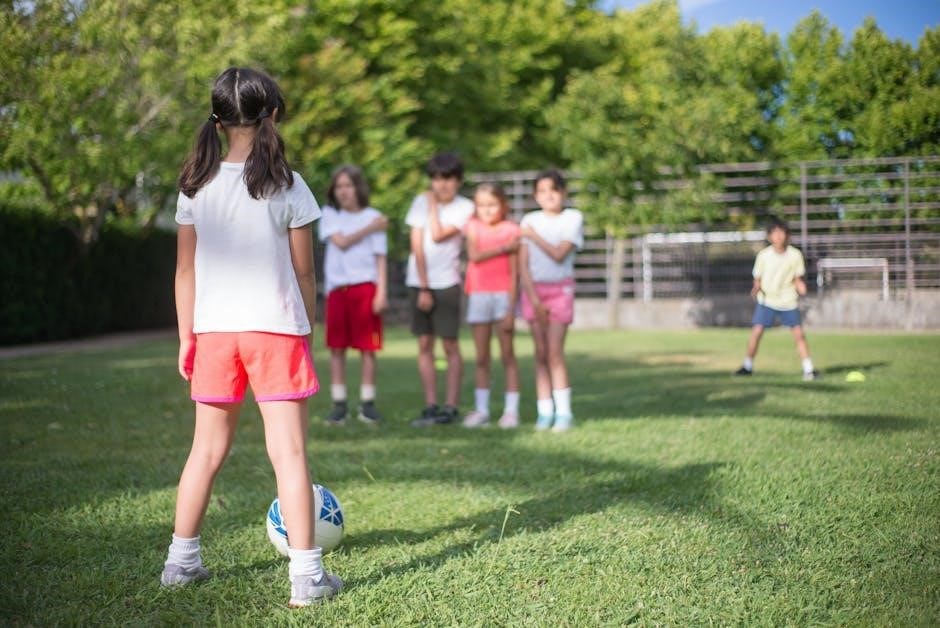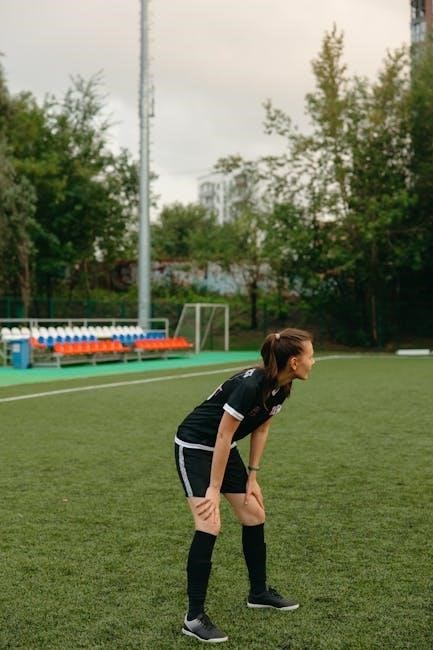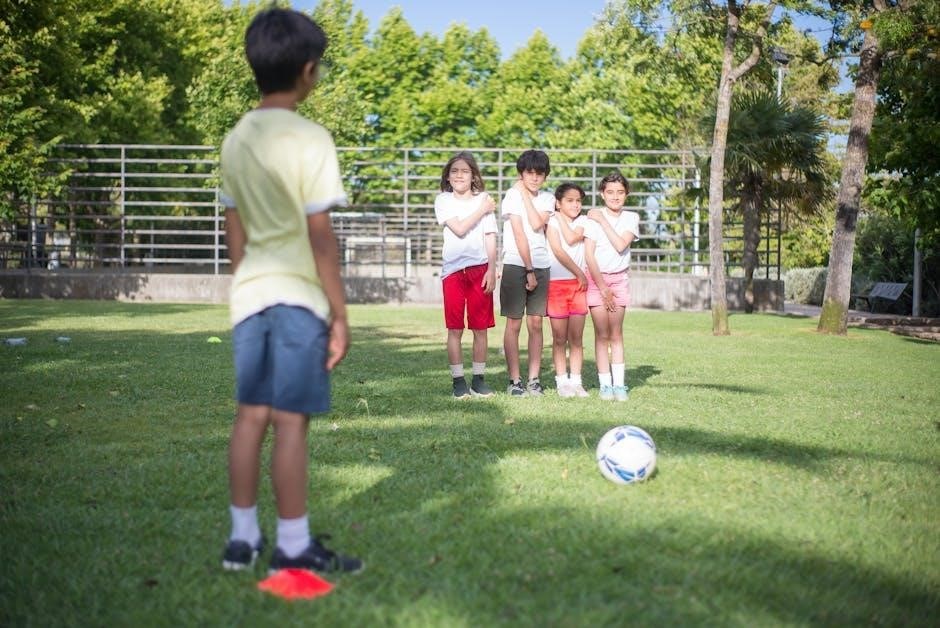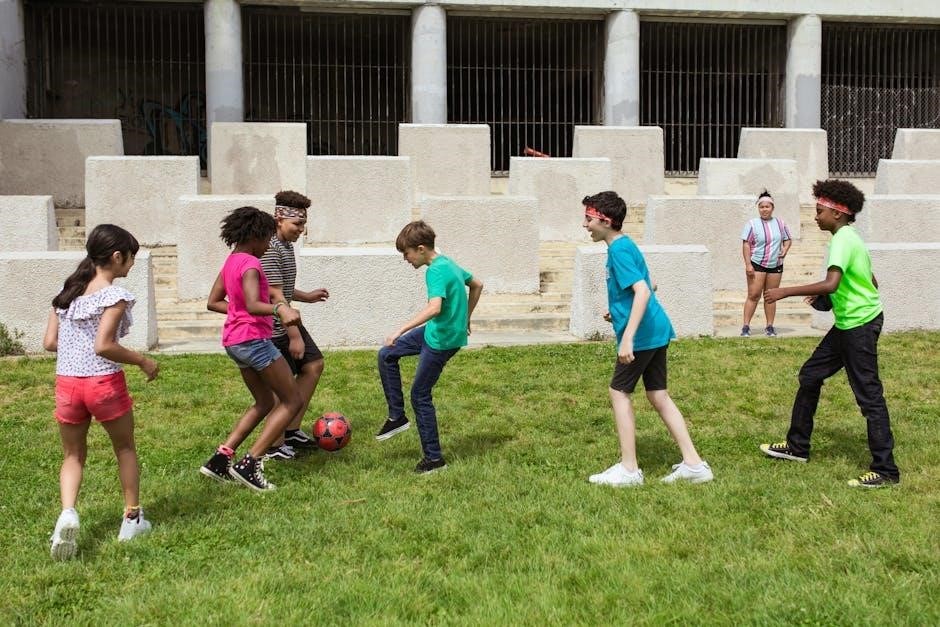Choosing the right soccer ball size is crucial for young players‚ as it impacts skill development and overall enjoyment of the game․ Properly sized balls ensure safety‚ better control‚ and improved technique‚ making them essential for youth training and matches․ Understanding size guidelines helps parents and coaches provide the best tools for growth in soccer․
Why Soccer Ball Size Matters for Youth Players
The size of a soccer ball is crucial for young players as it directly impacts their ability to control the ball and develop essential skills․ A ball that is too large or heavy can be difficult for a child to manage‚ leading to frustration and potential injuries․ Conversely‚ a ball that is too small may not provide an adequate challenge‚ hindering skill progression․ The right-sized ball ensures that children can handle it effectively‚ fostering better technique in dribbling‚ passing‚ and shooting․ Proper ball size also enhances coordination and balance‚ making the game more enjoyable and engaging․ As children grow‚ their physical abilities improve‚ and gradually increasing ball size supports their development․ Using the correct size is vital for safety‚ skill enhancement‚ and maintaining youngsters’ motivation and enjoyment of the sport․
FIFA Regulations for Soccer Ball Sizes
FIFA sets universal standards for soccer ball sizes‚ ensuring consistency across all levels of play․ Sizes 3‚ 4‚ and 5 are specified for different age and skill levels․
Official Size Guidelines for Youth Soccer Balls
Official size guidelines for youth soccer balls are designed to meet the needs of players at different developmental stages․ Size 3 balls‚ with a circumference of 23-24 inches and a weight of 11-12 ounces‚ are recommended for children aged 8 and under․ These smaller‚ lighter balls are easier for young players to control‚ helping them develop basic skills like dribbling and passing․ As players grow older and their skills improve‚ they progress to larger sizes․ Size 4‚ with a circumference of 25-26 inches and a weight of 13-14 ounces‚ is suitable for players aged 9-12‚ while Size 5‚ the standard for professional play‚ is used by players aged 13 and above․ Consistency in ball size ensures fair play and proper development across all age groups․
Understanding Soccer Ball Size Chart
A soccer ball size chart serves as a guide to help parents and coaches choose the right ball size‚ ensuring proper fit and safety for young players․
Size 3‚ 4‚ and 5 Balls: Age and Skill Requirements
Youth soccer balls are categorized into sizes 3‚ 4‚ and 5‚ each designed for specific age groups and skill levels․ Size 3 balls are recommended for children aged 8 and under‚ as they are smaller and lighter‚ making them easier to control for younger players․ Size 4 balls are suitable for players between the ages of 8 and 12‚ offering a balance between size and weight that supports skill development․ Size 5 balls are the standard for players aged 13 and above‚ mirroring the dimensions of professional soccer balls․ Proper sizing ensures that young players can handle the ball effectively‚ promoting better technique and overall performance․ Understanding these guidelines helps parents and coaches select the appropriate ball for their child’s age and skill level․
How to Choose the Right Soccer Ball for Your Child
Consider your child’s age‚ skill level‚ and FIFA standards when selecting a soccer ball․ Consider consulting a size chart to ensure the best fit and performance․
Determining the Correct Size Based on Age and Skill Level
Determining the correct soccer ball size for your child involves considering their age and skill level․ FIFA regulations provide clear guidelines‚ with Size 3 recommended for children under 8‚ Size 4 for those aged 8-12‚ and Size 5 for players 13 and older․ Skill level also plays a role‚ as younger players may benefit from smaller‚ lighter balls to improve control and technique․ Parents and coaches should refer to official size charts to ensure the ball matches the player’s age group and skill development needs‚ promoting optimal performance and enjoyment of the game․

The Importance of Ball Weight and Material
Ball weight and material significantly impact performance‚ with lighter balls suiting younger players for better control‚ while high-quality materials ensure durability and consistent playability․
How Ball Weight Impacts Performance for Young Players
Ball weight plays a critical role in a young player’s performance‚ as it directly affects control‚ movement‚ and overall skill development․ Lighter balls are easier for younger players to manage‚ allowing for better dribbling and precision․ Excessively heavy balls can hinder technique and speed‚ while appropriately weighted balls promote balanced play․ Proper weight distribution ensures the ball behaves predictably‚ helping players develop accurate passing and shooting skills․ Additionally‚ the right weight supports muscle development without causing strain‚ making it essential for both training and competitive games․ Ensuring the ball meets official weight standards is vital for optimal performance and safety in youth soccer․
Soccer Ball Construction: What Parents Need to Know
Soccer balls are made from panels stitched together‚ typically 32 or 26‚ affecting aerodynamics and control․ Materials like leather or synthetic impact durability and feel‚ ensuring optimal performance and safety for young players․
Differences in Ball Panels and Their Effects on Play
Soccer balls are constructed with panels stitched together‚ typically 32 or 26‚ which influence aerodynamics and control․ Fewer panels‚ like 26‚ create a smoother surface‚ improving ball flight consistency and reducing drag‚ making it easier for young players to control․ More panels‚ such as 32‚ provide a larger “sweet spot” for precise kicks and headers‚ suitable for advanced skills․ The panel design also affects durability and responsiveness‚ with higher-quality materials ensuring better performance․ Understanding panel differences helps parents and coaches choose balls that match skill levels‚ enhancing playability and skill development for youth players․

The Impact of Proper Ball Size on Skill Development
Proper ball size enhances dribbling‚ control‚ and shooting skills in young players․ A ball that matches their age and ability fosters better technique and confidence‚ driving improvement․
How the Right Ball Size Enhances Dribbling and Control
The right soccer ball size significantly improves a young player’s ability to dribble and control the ball․ A ball that is too large or too small can hinder proper technique‚ making it difficult for players to master fundamental skills․ When the ball is appropriately sized‚ players can better manage its movement‚ allowing for sharper turns and quicker changes in direction․ This enhances agility and coordination‚ which are essential for effective dribbling․ Additionally‚ proper ball control is easier to achieve with a size-matched ball‚ enabling players to maintain possession and execute precise passes․ The correct size fosters confidence and improves overall performance‚ making it a critical factor in skill development for young athletes․

Common Mistakes When Selecting a Youth Soccer Ball
A common mistake is choosing a ball too large or small for the player’s age and skill level‚ which can hinder technique development and performance․
Avoiding the Wrong Size for Your Child’s Age Group
Selecting the wrong soccer ball size can hinder a child’s performance and enjoyment․ A ball that’s too large may be difficult to control‚ while one that’s too small can lead to poor technique․ It’s essential to follow official guidelines‚ which recommend specific sizes based on age groups․ For example‚ younger players typically use Size 3 balls‚ while older youth use Size 4 or 5․ Ignoring these recommendations can result in frustration and slower skill development․ Parents and coaches should consult size charts to ensure the right fit‚ fostering better dribbling‚ passing‚ and shooting abilities․ Proper sizing supports growth and confidence in young athletes․

FAQs About Youth Soccer Ball Sizes
What is the correct size for my child? How does ball weight affect performance? Are all soccer balls suitable for youth players? These questions and more are addressed in this section to ensure informed decisions for optimal skill development and safety․
Answering Key Questions for Parents and Coaches
Q: What is the correct soccer ball size for my child? A: Size depends on age and skill level‚ with Size 3 for ages 8 and under‚ Size 4 for ages 9-12‚ and Size 5 for ages 13 and above․ Q: How does ball weight impact performance? A: Lighter balls are easier for younger players to control‚ while heavier balls build strength and accuracy․ Q: Are all soccer balls suitable for youth players? A: No‚ choose balls meeting FIFA standards for safety and performance․ Q: How often should soccer balls be replaced? A: Replace them when they lose shape or show significant wear․ Q: Can smaller balls improve skill development? A: Yes‚ smaller balls enhance dribbling and control for younger players․ Q: How do I ensure the ball is properly inflated? A: Follow the manufacturer’s guidelines for optimal performance and longevity․ Ensuring the right size and quality helps young players develop their skills effectively and safely․
Selecting the right soccer ball size for your child ensures proper skill development‚ safety‚ and enjoyment․ Always consider age‚ skill level‚ and FIFA guidelines for the best fit․
Final Tips for Making the Best Choice
When selecting a youth soccer ball‚ prioritize age-appropriate sizing and ensure it meets FIFA standards for weight and quality․ Consider the child’s skill level and playing surface‚ as some balls are designed for indoor or outdoor use․ Durability is key‚ so opt for high-quality materials that can withstand regular play․ Additionally‚ involve your child in the selection process to ensure they feel comfortable with the ball’s size and weight․ Remember‚ the right ball enhances performance and confidence‚ fostering a lifelong love for the sport․ Always double-check size charts and seek advice from coaches if unsure․
